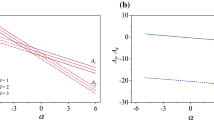Abstract
A vast literature exists on the Benard flow, the vertical thermal convection flow, but almost no result is known on the horizontal counterpart. On account of the wide range of applications in geophysics, astrophysics, metereology, and material science; we think that the horizontal thermal convection flow deserves as much consideration as the Benard problem. The present study is the first step towards the description of the bifurcation pattern of the horizontal thermal convection flow. We present several flow configurations of an incompressible Navier-Stokes fluid contained in a 4 × 1 × 1 parallelepipedic box with open top and vertical transversal walls at different temperature. The flow induced by the buoyancy force and the thermocapillary effects at the fluid/air interface is numerically computed within the Boussinesq approximation. The velocity-vorticity formulation with a fully implicit finite difference method are implemented in a parallel computational code. The strong coupling of the discrete equations ensures the correct mass balance at each time step and provides true-transient numerical flows. For fluids at Prandtl number Pr = 0.015 (semiconductors and liquid metals), we describe the changes in shape of the main vortex and the intensity of the speed of the flow versus variations of the Grashof number. In the case of absence of thermocapillary effects, we observe that as Gr increases, the flow exhibits more and more three-dimensional effects. When we add the thermocapillary effects, we observe an increase of the speed of the flow with the formation of a steep boundary layer around the liquid/air interface.
Similar content being viewed by others
REFERENCES
Baldoni, F., and Rajagopal, K. R. (1997). A continuum theory for the thermomechanics of solidification, Int. J. Nonlin. Mech. (to appear).
Batchelor, G. K. (1954). Heat transfer by free convection across a closed cavity between vertical boundaries at different temperatures, Quart. Appl. Math. 12, 209–233.
Behnia, M., Stella, F., and Guj, G. (1995). Numerical study of three-dimensional low-Pr buoyancy and termocapillary convection, Num. Heat Transfer Part. A 27, 73–88.
Ben Hadid, H., and Roux, B. (1989). Buoyancy-and thermocapillary-driven flows in differentially heated cavities for low-Prandtl-number fluids, J. Fluid Mech. 235, 1–36.
Ben Hadid, H., and Roux, B. (1992). Buoyancy and thermocapillary—Driven flows in differentials heated cavities for Low-Prandtl-number, J. Fluid Mech. 235, 1–36.
Braunfurth, M. G., Skeldon, A. C., Juel, A., Mullin, T., and Riley, D. S. (1997). Free convection in liquid gallium, J. Fluid Mech. 342, 295–314.
Cormack, D. E., Leal, L. G., and Imberger, A. (1974). Natural convection in a shallow cavity with differentially heated end-walls. Part I. Asymptotic theory, J. Fluid Mech. 65, 209–219.
Crochet, M. J., Geyling, F. T., and Van Schaftingen, J. J. (1987). Numerical simulation of the horizontal Bridgman growth. Part I: Two-dimensional flow, Int. J. Num. Meth. Fluids 7, 29–47.
De Vahl Davis, G. (1986). Finite difference methods for natural and mixed convection in enclosures, Heat Transfer 1, 101–109.
Dupont, S., Marchal, J. M., Crochet, M. J., and Geyling, F. T. (1987). Numerical simulation of the horizontal Bridgman growth. Part II: Three-dimensional flow, Int. J. Num. Methods Fluids 7, 46–67.
Elder, J. W. (1965). Laminar free convection in a vertical slot, J. Fluid Mech. 23, 77–98.
Fauve, S., and Libchaber, A. (1983). Ann. NY Acac. Sci. 404, 34–52.
Gershuni, G. Z., Laure, P., Myznikov, V. M., Roux, B., and Zhukhovitsky, E. M. (1992). On the stability of plane-parallel advective flows in long horizontal layers, Microgravity Quart. 2, 141–151.
Gill, A. E. (1974). A theory of thermal oscillations in liquid metals, J. Fluid Mech. 64, 577–588.
Hart, J. (1983). A note on the stability of Low-Prandtl-number Hadley circulations, J. Fluid Mech. 132, 271–281.
Hurle, D. T. J. (1983). Convective transport in melt growth system, J. Crystal Growth 65, 124–132.
Kremenetsky, M., and Rothberg, Ed. (Undated). A parallel solver for sparse matrices, SGI Int'l. Technical Report.
Laure, P. (1987). Etude des mouvements de convection dans une cavite rectangulaire soumise à un gradient de temperature horizontal, J. Méc. Theéor. Appliquée 6, 351–382.
Laure, P., Roux, B., and Ben Hadid, H. (1990). Nonlinear study of the flow in a long rectangular cavity subjected to thermocapillary effects, Phys. Fluids A 2, 516–524.
Mansutti, D., Baldoni, F., and Rajagopal, K. R. (1996). The influence of the kinematical fields on the solidification of a semi-infinite water layer. Technical Report, Quaderno I.A.C. [submitted for publication Math. Mod. Meth. Appl. Sci.]
Muller, G., and Neumann, G. (1983). J. Crystal Growth 63, 58–88.
Peltier, L. J., and Biringen, S. (1993). Time-dependent thermocapillary convection in a rectangular cavity: Numerical results for a moderate Prandtl number fuilds, J. Fluid Mech. 257, 339–357.
Pulicani, J. P., Crespo, E., Randriamampianina, A., Bontoux, P., and Peyret, R. (1990). Spectral simulation of oscillatory convection at low Prandtl number, Int. J. Num. Methods Fluids 10, 481–517.
Radicati di Bronzolo, G., and Vitaletti, M. (1989). Conjugate-gradient subroutine for the IBM 3090 vector facility, IBMJ Res. Dev. 33, 125–135.
Roux, R. (1990). Numerical simulation of oscillatory convection in low-Prandtl fluids, Notes on Numer. Fluid Mech., Vol. 27, Vieweg Publishers.
Stella, F., and Bucchignani, E. (1996). True transient vorticity-velocity method using preconditioned Bi-CGstab, Num. Heat Transfer Part B 30, 315–339.
Villers, D., and Platten, J. K. (1987). Separation of Marangoni convection from gravitational convection in earth experiments, Phys. Chem. Hydrodynamics 8, 173–183.
Winters, H. K. (1988). Oscillatory convection in liquid metals in a horizontal temperature gradient, Int. J. Numer. Methods Eng. 25, 401–414.
Author information
Authors and Affiliations
Rights and permissions
About this article
Cite this article
Giangi, M., Mansutti, D. & Richelli, G. Steady 3D Flow Configurations for the Horizontal Thermal Convection with Thermocapillary Effects. Journal of Scientific Computing 14, 179–195 (1999). https://doi.org/10.1023/A:1023280703869
Issue Date:
DOI: https://doi.org/10.1023/A:1023280703869




